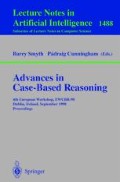Abstract
Apart from the classification accuracy the solution time is one of the most critical factors in real world applications, especially in real-time intelligent systems. Maximum time t is often known and it must not be exceeded during solving a new case. Knowing parameter t in Case-Based Reasoning systems, the maximum size of the case base can be determined in such a way that the solution time is shorter than t. In order to keep the case base to the proper size obsolete cases should be replaced by new ones. This approach can easily reflect the dynamic of changing environment. In order to verify this idea we introduced five replacing heuristics that are empirically evaluated. The experimental results are promising in demonstrating that the competence of the system might not significantly deteriorate while working with a limited number of cases.
Preview
Unable to display preview. Download preview PDF.
References
Aha, D.W. (1992). Tolerating noisy, irrelevant and novel attributes in instance-based learning algorithms. Int. J. Man-Machine Studies, 36, 267–287.
Dasarathy, B.V. (Ed.). (1991). Nearest neighbour(NN): NN pattern classification techniques. Los Alamitos, CA: IEEE Computer Society Press.
Huang, Y. (1996). An Evolutionary Agent Model of Case-Based Classification. In eds. Smith and Faltings Advances in Case-Based Reasoning, Third European Workshop, EWCBR-96, Lausanne, Springer Verlag, 193–203.
Francis, A.G., Ram, A. (1993). The Utility Problem in Case-Based Reasoning. Technical Report WS-93-01, AAAI Press.
Langley, P. (1995). Order Effects in Incremental Learning. In Learning in Humans and Machines, Elsevier Science Ltd.
Markovitch, S., Scott, P.D. (1988). The Role of Forgetting in Learning. In Proceedings of the Fifth International Conference on Machine Learning, 459–465.
Merz, C.J., Murphy, P.M. (1998). UCI Repository of machine learning databases [http://www.ics.uci.edu/ mlearn/MLRepository.html]. Irvine, CA: University of California, Department of Information and Computer Science.
Smyth, B., Keane, M.T. (1995). Remembering to Forget: A Competence-Preserving Deletion Policy in Case-Based Reasoning Systems. In Proceedings of the Fourteenth International Joint Conference on Artificial Intelligence, Montreal, Morgan Kaufmann, 377–383.
Author information
Authors and Affiliations
Editor information
Rights and permissions
Copyright information
© 1998 Springer-Verlag Berlin Heidelberg
About this paper
Cite this paper
Surma, J., Tyburcy, J. (1998). A study on competence-preserving case replacing strategies in case-based reasoning. In: Smyth, B., Cunningham, P. (eds) Advances in Case-Based Reasoning. EWCBR 1998. Lecture Notes in Computer Science, vol 1488. Springer, Berlin, Heidelberg. https://doi.org/10.1007/BFb0056336
Download citation
DOI: https://doi.org/10.1007/BFb0056336
Published:
Publisher Name: Springer, Berlin, Heidelberg
Print ISBN: 978-3-540-64990-8
Online ISBN: 978-3-540-49797-4
eBook Packages: Springer Book Archive

